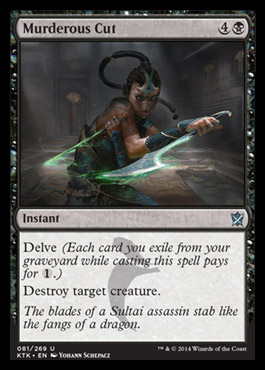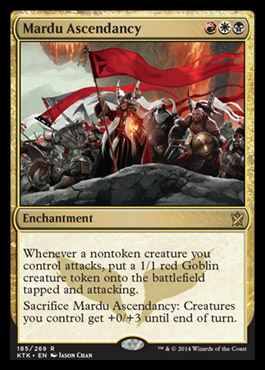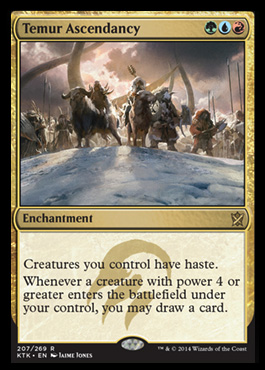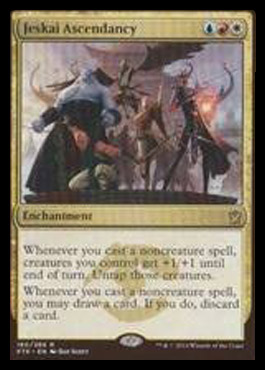Are you a Quiet Speculation member?
If not, now is a perfect time to join up! Our powerful tools, breaking-news analysis, and exclusive Discord channel will make sure you stay up to date and ahead of the curve.
Shards of Alara is my favorite block of all time and so the fact that we are heading into another tri-colored block is extremely exciting for me. I fell in love with Naya immediately after that shard was released and I have memories from playing that shard that I’ll never forget.
For a lot of us, we have a deep connection to one shard or wedge so I expect this set to create a lot of emotions from players. There will be some who jump for joy because their dreams of their favorite color combination finally having a name, albeit an awkward one, are finally coming true. We have waited for wedges for years and now they are finally here. It’s going to take some time for us to get used to Sultai instead of BUG, Jeskai over American, Abzan rather than Junk, and Temur in place of RUG.
Red-Black-White never really had a name that stuck. Aristocrats is the only thing that reminds us of that color combination and that happened within recent memory. I expect Mardu to be one of the names that catches on first because we don’t have to replace our previous name for a wedge, we just get to finally call it something. Why they choose such odd names for the wedges we may never know, but they are fitting for the world we are visiting. I wish they stuck to four or five letter names that were easy on the tongue and ears. If my polls are any indication, the names will stick regardless of their awkwardness.
The wedge that has me the most excited is Sultai. This surprises me because it’s not a combination I am used to playing. There have been a couple of strategies, like BUG Delver in Modern or my Damia, Sage of Stone Commander deck, where I have utilized the Sultai wedge. Outside of those two experiences, I have not utilized those three colors of this game together. The reason I am so excited about this wedge is because there is an obvious strategy present and one I expect to be quite good upon rotation.
Last week I talked about Sultai Dredge and what it might look like in the new format. Since then, my thought process as well as newly spoiled cards have altered my perspective. Here are the two cards responsible.


As I was playing around with the dredge deck, I kept noticing that none of the removal spells in the format were a good fit for the deck. Sultai Charm seems okay but that alone doesn’t seem like enough. I kept thinking about what card could replace the catch-all Shadowborn Demon. Then I saw Murderous Cut.
I joked that all I wanted was a removal spell with delve and I actually got my wish! Until you start playing with Murderous Cut you can’t see how good it is. Most of the games play out with you setting up your strategy. The first couple of turns always involve playing mana guys and Satyr Wayfinder, Commune with the Gods, or Nyx Weaver.
The turns you start needing your removal spell are usually three through five. Murderous Cut fits in that spot like the last piece of the puzzle snapping into place. This card is like the one piece that shows you what the picture is. You’ve been building this puzzle for a while but the picture wasn’t clear until you found the right piece to complete the picture.
Don’t underestimate it either. Firstly, it kills anything. These days when most of our removal spells only hit a specific subtype of cards, being able to kill any creature is a huge boon. Secondly, and most importantly, this card never costs five mana. Most of the time you have four non-creature cards in your graveyard for this to cost only a single mana. That’s right, the best removal spell in the format costs one mana in this deck! Sure there will be times when that’s not the case, but often you will be able to progress your board state and stunt your opponents all for the cost of a single black mana.
Examining the Ascendancies
Sultai Ascendancy is not a card I thought was good enough for Standard. It is slow and its effect can seem uninfluential upon the outcome of the game. The problem with this and the other Ascendancies is that most of them don’t affect the board until the turn after they are cast. What I’ve learned is that they are so good that using your turn to cast them is setting yourself up to win.
Let’s take Sultai Ascendancy as our first case study. The initial aspect of the card that should be noted is that it can help you fill your graveyard. In our graveyard-based deck, filling the graveyard is our primary goal. It helps us cast cheap Nemesis of Mortals as well as allowing our Nighthowlers to become huge. Additionally, now that we’re delving with Murderous Cut, those extra cards put in the graveyard every turn keep our engine going.
The second important aspect of the card is it helps filter our draws. Once you start peeking at the top two and deciding whether or not you like those cards, it will be hard to return to normal Magic. I thought I wouldn’t like this card and I was quite skeptical about it, but testing with it has proven it to be much better than my expectations. Not only does it enable the deck by filling your graveyard, but basically scry 2 every turn is obviously powerful.
Other Ascendancies are going to be great in Standard as well. The fantastic part about this cycle is that when you read each of them, it’s easy to start brewing with them as the core of your deck. Take Mardu Ascendancy for example.

With Mardu Ascendancy, I immediately have a whole tree full of branches sprouting different ideas. This Ascendancy pushes us to start our mana curve below three so that the turn we play it the game is impacted right away. We could take that base idea and apply it to any of the three mono-colored decks but most likely we would end up removing the sweet enchantment for consistency purposes.
By using one of the colors as our base though, we could add a second support color and splash the third color. Is this strategy going to be heroic, tribal, or just efficient creatures in the colors? We have so many powerful early creatures in these colors that it’s unclear which will prove the best combination to play, but the effect from this enchantment is so powerful that it’s worth exploring all of our options.

The junk Ascendancy seems extremely powerful at first glance, and it’s already been suggested that I add some copies to my Melira-Crats deck that I wrote about a couple weeks ago. The conflicting part about Abzan Ascendancy is that the first ability synergizes well with tokens, but the second ability encourages you to play more actual creatures.
I would guess that for this enchantment to work, you would need a nice mix of creatures and token producers. Launch the Fleet, for example, seems like it would have a great home in this type of deck because all of those tokens would get counters. Either way you look at it, Abzan gets two powerful effects on their Ascendancy.

Temur Ascendancy seems like the part of this cycle I would enjoy the most because it’s the most similar to Naya, my favorite, but I’m having a hard time getting on board. The problem is that despite how it seems to fit right into the Temur strategy of porting current Standard into the new format, this RUG Monsters type deck already has so many good three-drops.
Courser of Kruphix is obviously going into any midrange deck until it rotates out and the new Savage Knuckleblade looks too good not to play. It’s not that almost having Garruk's Packleader plus Fires of Yavimaya on one card is a bad thing, it’s just that it has a hard time not clogging up the deck.
In a certain sense it does a reasonable job replacing Domri Rade’s spot in a Monsters type deck and maybe only playing one or two copies is the way to go anyway, so we don’t need to worry about clogging up the deck at the three spot. Regardless, this is a potent card, as is this entire cycle. They all push the envelope of what a three-mana enchantment can do in competitive magic.

Jeskai Ascendancy is the newest enchantment to the party and I’m glad I was able to add this one in at the last second. This entire clan makes me wish that Young Pyromancer was not rotating out of the format. The Eternal staple never really made waves in Standard and I feel like he would certainly have made friends with the Jeskai.
This enchantment gives bonuses to your creatures when you play a spell. Will it be possible to play a Jeskai deck that has the right balance of creatures and spells in order to play cards like this? My inclination is no, but we’ll see what other cards are spoiled in the set before I pass judgment.
All of the cards in this cycle are powerful and we all can see that just by reading them. Will they turn out like the weapons from Theros block? Or will they be the centerpieces of decks in the format? Only time will tell. Brewers rev your engines because Khans of Tarkir has reignited the flames in the brew house. There are so many possibilities for the new format. I can’t wait to explore more of them with you guys.
Standard Manabases
Mana in the new Standard is going to take some getting used to. I’ve noticed from my initial work with Sultai that the green wedges in particular have an uneasy alliance between Elvish Mystic and their respective tri-land. Opulent Palace, Sandsteppe Citadel, Frontier Bivouac are difficult to play alongside our wonderful mana elf.
The importance of Elvish Mystic ramping any green deck is essential, but it does come with a cost of less efficient mana. In one sense it would be nice to have a tri-land half the time and the other half, set yourself up with Elvish Mystic. While that does happen, sometimes the two will sit alongside each other in your hand waiting for you to make a decision on your first turn.
My initial impression is that our mana will push us to a more midrange format just like the last time we had a setup like this. The similarities between Khans of Tarkir and Shards of Alara are growing but that is a positive thing in my opinion. I hope it turns out that way in the end.
I have questions like, will aggro be rooted out of the format due to inconsistent mana plus Drown in Sorrow and Anger of the Gods? Is mono-colored aggro a possibility with the card pool? Can an aggressive deck support three colors and if so, what do those mana bases look like? We have a lot of exploration ahead of us.
Using Shards of Alara Standard to help us better understand Khans of Tarkir seems like the right place to start. Lots of authors have talked about what the mana might look like but here is a specific example.
Naya by Mike Lanigan (States 2008 Top 8)
As you can see, I used a combination of pain lands and fetch lands to stabilize my manabase. At that time I also was able to utilize some filter lands to help cast Woolly Thoctar. We unfortunately don’t have any other multicolored lands that come into play untapped similar to the filter lands. Instead, we need to decide if we are going to play any lands that come into play tapped in our aggro decks.
Even though Jungle Shrine was legal at the time, I did not include it in my Naya deck because the fact that it couldn’t be used the turn you played it was too large a liability. I suspect the same will be true in Standard. The question is, do we make sacrifices or not? The balance we need to determine is consistency vs. speed. Mana Confluence is there to help all aggressive decks as well.
That’s all for me for today. What are your thoughts on the cards I’ve talked about today? Post them in the comments and come back next week for my latest installment of the Top 10!
Until Next Time,
Unleash the Khans Force!
Mike Lanigan
MtgJedi on Twitter
Jedicouncilman23@gmail.com





t1 Bloodsoaked Hero
t2 Warname Aspirant (swing 2)
t3 Mardu Ascendancy (swing 7)
t4 Butcher of the Hoard swing (swing 13)
That’s a pretty convincing goldfish.